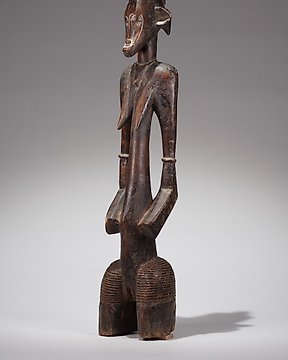
Senufo - Elefántcsontpart (Nincs minimálár)
Nr. 84131519

Nr. 84131519

An elegant female Senufo Rhythmpounder, called "déblé" , Northern Ivory Coast, probably village Nafou - uprising from a cylindrical, base with slightly bent legs, the openwork arms carved beside a slender body with a small pointed navel, the columnar neck supporting a zoomorphic head witha prominent snout, wearing a domed, single crested coiffure, scarification patterns at the body and around the navel; aged patina, the neck, the arms and the base of the statue with significant signs of use, the sculpture is still in the original condition like it was collected in situ. Normally these traces of use are washed off as soon as these objects arrive on the Western market. Condition report: The right arm at the hand has a nearly unvisibale crack. Pleases don´t touch the sculpture with force during the unpacking.
According of Gottschalk, who tryed to make a typolgy of the Senufo Déblé these exemplares would be probably submitted to the group of the kulibèlè and not the fonombèlè.
"While the former (fonombèlè), either due to a lack of ability for finer work (the fonombèlè are the blacksmiths in the Senufo society) or as a consciously used stylistic device, left the clear and powerful forms, the contrasting horizontals and verticals, largely as they were when defining the Once the proportions were created, the kulibèlè (the traditional carvers) strive to ensure that the body parts flow smoothly into one another, as long as they did not incorporate the style of their older brothers into their work or more or less copy it." Gottschalk Burkhard, "Senufo, Massa und die Statuen des poro" 2002: 43.
More realistic sounds the opinion of Glaze, who described the difficulties of a stylistic typology according of both ethnic groups after she did fieldwork around kufulo (region of Dikodougou)Glaze Anita J., "Art and Death in a Senufo Village", Indiana University Press, Bloomington 1981.
Hogyan vásárolhatok a Catawiki-n?
1. Fedezzen fel valami különlegeset
2. Tegye meg a legmagasabb licitet
3. Fizessen a biztonságos és védett rendszert használva